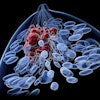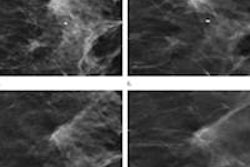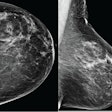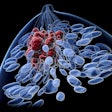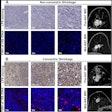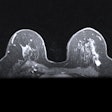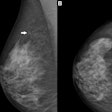Adding digital breast tomosynthesis (DBT) to digital mammography for screening appears to have many benefits, including greater sensitivity in dense breast tissue and fewer recalls. But the technology also classifies noncalcified breast lesions more accurately in the diagnostic setting, according to research presented at the RSNA 2014 meeting.
The findings suggest that the use of tomosynthesis mitigates what some call the "harms" of breast cancer screening, such as repeated follow-up tests and ensuing patient anxiety and healthcare costs, said presenter Dr. Madhavi Raghu of Yale University.
"Prior studies have shown that tomosynthesis not only reduces false positives in screening, it also results in better assessment of lesions in the diagnostic setting, which suggests that fewer studies may require close imaging follow-up," Raghu told session attendees.
Raghu's team reviewed all diagnostic mammograms performed with tomosynthesis over a 30-month period, with year 1 spanning January 2012 to January 2013, year 2 covering January 2013 to January 2014, and a six-month period covering January to July 2014. The group determined each exam's final BI-RADS assessments.
During the study time period, 12,864 diagnostic mammograms were performed. In year 1, 64% of these were done with the addition of tomosynthesis; in year 2, 88% were performed with tomosynthesis, and in the final six-month period, 96% were done with tomosynthesis.
From year 1 to the end of the study time frame, there was a 10-percentage-point increase in the proportion of studies assessed as benign, or BI-RADS 1 or 2, from 66% to 76%. BI-RADS 3, or probably benign, assessments decreased by eight percentage points over the study period, from 25% to 17%. Finally, there was a 12-percentage-point increase in the positive predictive value of biopsies performed on BI-RADS 4 and 5 lesions, Raghu said, from 40% to 52%.
"Workup with tomosynthesis significantly improves diagnostic accuracy and confidence," Raghu told session attendees. "We found that more studies were categorized as benign, fewer patients were recommended for short-interval follow-up imaging, and the specificity of biopsy recommendations improved."
Redefining BI-RADS 3
During the same session, Raghu shared findings from a related study her team conducted to investigate the number, type, and mammographic manifestations of lesions found with tomosynthesis and categorized as BI-RADS 3 -- specifically, how many turned out to be malignant.
This study used the same data and the same time frame. Raghu and colleagues identified all diagnostic exams performed with the addition of DBT that were categorized as BI-RADS 3 between January 2012 and July 2014. They also examined follow-up data over a period that ranged from six to 18 months.
"We evaluated the outcomes of all BI-RADS 3 studies reclassified as 'suspicious' or 'highly suggestive of malignancy' -- that is, BI-RADS 4 or 5," she said. "Mammographic features included masses, calcifications, architectural distortions, and asymmetries."
Of 10,217 diagnostic mammograms performed with tomosynthesis during the study time frame, 25% were classified as BI-RADS 3 in year 1, 21.7% in year 2, and 17% in the final six-month period.
During follow-up, 101 studies were reclassified as BI-RADS 4 or 5 and biopsied. Of these, 23 were malignant, for a rate of 1% of the total number of lesions originally categorized as BI-RADS 3. Thirteen of these cancers were invasive ductal carcinoma, five were ductal carcinoma in situ, and five were invasive lobular carcinoma, Raghu said.
So what kind of mammographic features were associated with malignancy? Fourteen of the cancers were masses, six were calcifications, and three were architectural distortions; none of the asymmetries resulted in a malignant outcome, according to Raghu.
The findings could change the way the BI-RADS 3 category is defined, she said.
"Given that the malignancies were masses, calcifications, and distortions, the criteria for 'probably benign' lesions could be redefined when diagnostic workup is performed with tomosynthesis," she concluded.



